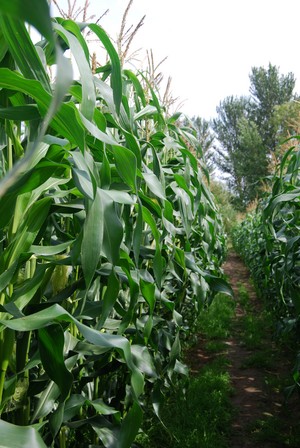Earlier this week I was watching TV with our grandchildren. It was a children’s programme on dinosaurs; a subject that captivates our grandson. The presenter said that dinosaurs did not eat grass because they existed before grass existed. This came as a complete surprise to me and so I looked into this a little further.
It appears that the programme was partly right and partly wrong. Dinosaurs almost certainly preceded grasses but by the time they were wiped out at the end of the cretaceous period (around 66 million years ago) there was some diversity in grass species, suggesting that they too had been around for a few million years.
Grasses now form an essential element of global nutrition, despite the fact that they evolved relatively late. Cereals, including wheat, barley and oats, millet, sorghum, maize and rice now provide just below 50% of the world’s dietary energy. This varies from country to country and continent to continent. In developing countries the average is 55% and in industrialised countries it’s around 35%.
The data demonstrates that reliance on cereals as an energy source for humans declines with increasing affluence. This is reinforced by the fact that in Africa, this reliance has fallen from over 60% to 55% over the last few decades. Increasing affluence can also explain the much reduced reliance on rice in favour of wheat in many developing countries.
Another grass not included in the above list is sugar cane which produces around 75% of the world’s sugar supply in addition to being a major feedstock for ethanol production.
In terms of the history of the world, it’s been only a couple of ticks since most of these crops have developed.  I’ve written before about the chance hybridisation of three grass species around 10,000 years ago that resulted in what we now call wheat. This occurred in the Fertile Crescent, which includes Israel, Lebanon, Syria, Iran and Iraq. It took around 3,000 years before it was cultivated in France and another 1,000 years before any production in the UK.
I’ve written before about the chance hybridisation of three grass species around 10,000 years ago that resulted in what we now call wheat. This occurred in the Fertile Crescent, which includes Israel, Lebanon, Syria, Iran and Iraq. It took around 3,000 years before it was cultivated in France and another 1,000 years before any production in the UK.
Genetic evidence has shown that rice originates from a single domestication in China 8,200–13,500 years ago. It was introduced to Europe through Western Asia, and to the Americas through European colonisation. There is a huge area in the Po Valley in Italy that’s devoted to paddy rice and I’ve witnessed its production next to the Murray River in Australia so it remains a crop grown on a global scale.
Maize was first cultivated in Mexico at about the same time as wheat was first grown in the Fertile Crescent. 
Of course pasture grasses also significantly contribute to human nutrition. However, this week I’m more interested in amenity grasses. It’s the US Masters Golf tournament, held every year on the same course in Augusta on the border between Georgia and South Carolina. It’s a place that I’d always wanted to visit since watching the tournament on TV as a child. We actually managed to attend in 2011 and 2013 and the course is stunningly beautiful and the grass is perfect even in parts of the course which only golfers of my aptitude visit. So it’s now a four-day lock-down until the final putt drops.
